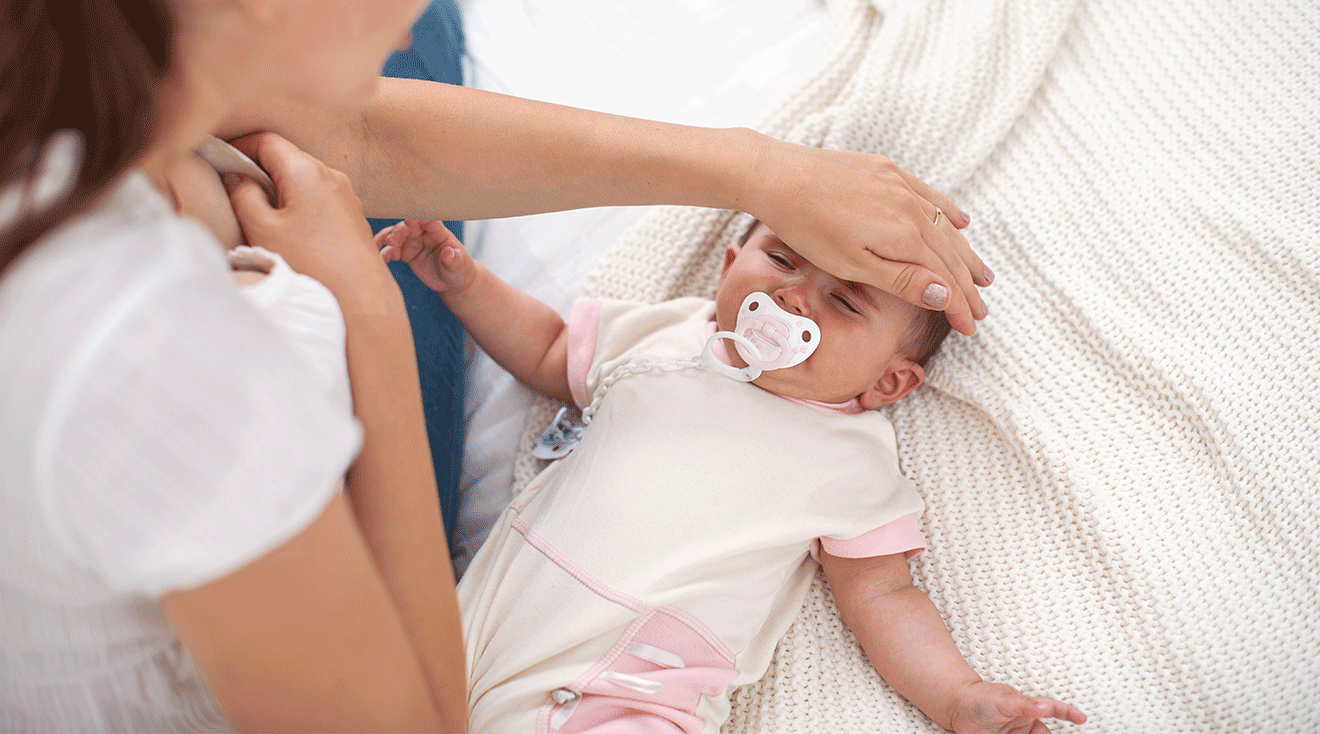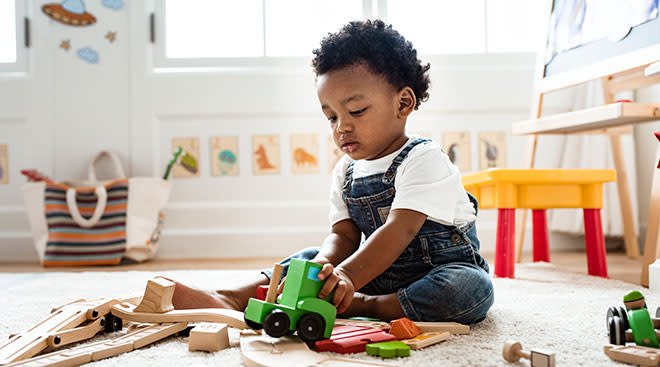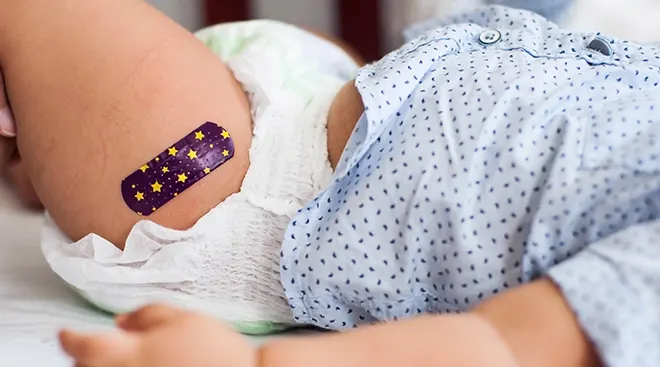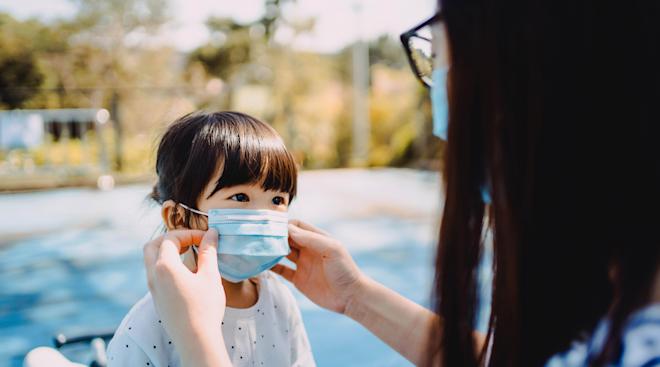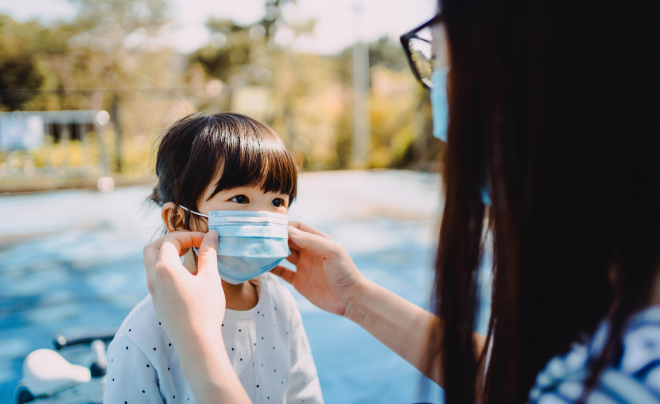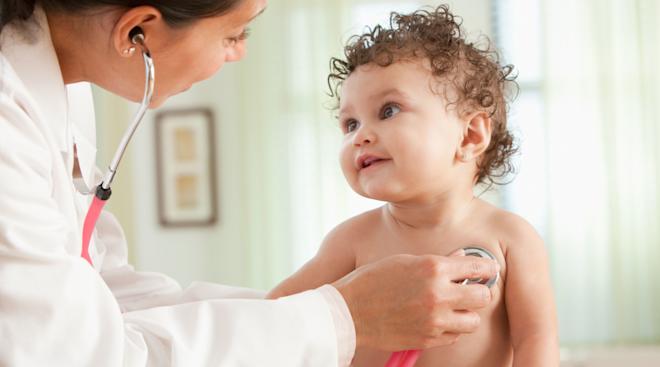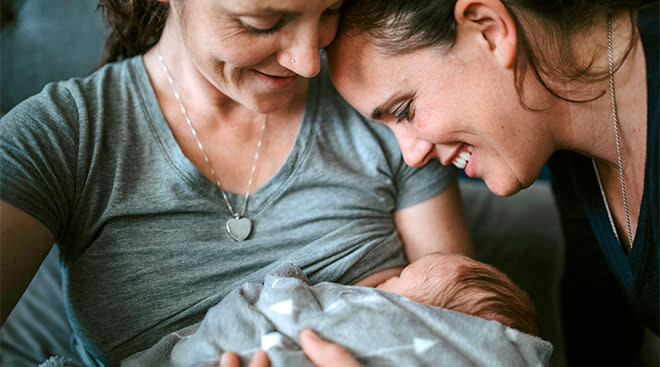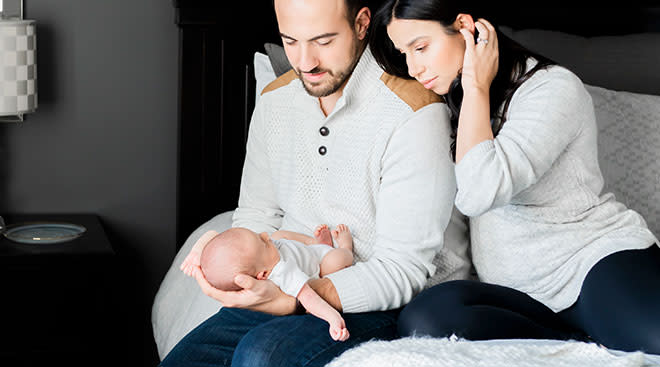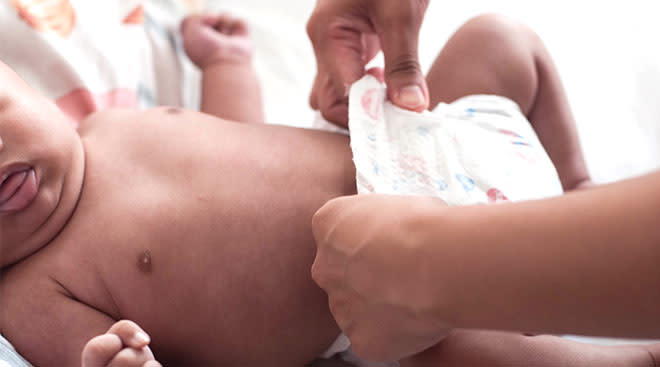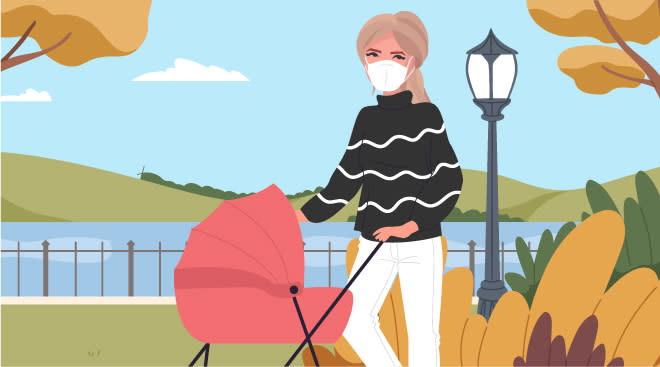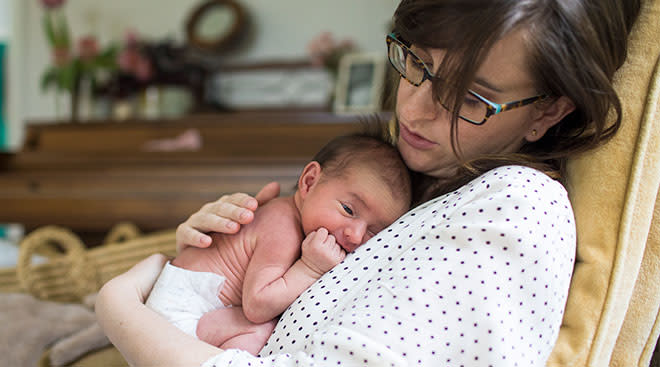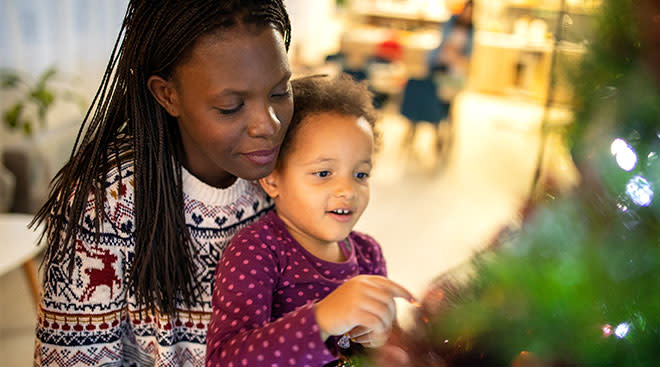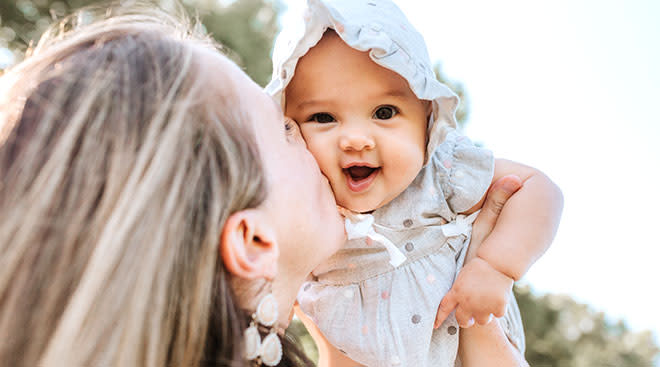What to Know About COVID in Babies and Toddlers
The threat of COVID-19 is unfortunately a part of life and, as a parent, that can feel extra scary. After all, we want to do everything we can to protect our kids and our families. With so much information (and misinformation) out there, it’s hard to distinguish the facts from fiction. That’s why we’re sharing information straight from infectious disease experts. What are the COVID symptoms in babies and toddlers to look out for, and can they even be tested for the virus? Moreover, when can kids get the COVID vaccine? Here’s what you need to know, plus tips to keep your kids safe.
Human coronaviruses are actually fairly common, according to the Centers for Disease Control and Prevention (CDC). There are seven different types of coronaviruses known to scientists, and most of them cause mild illness like colds, says William Schaffner, MD, an infectious disease specialist and professor at the Vanderbilt University School of Medicine in Nashville, Tennessee. However, three types of coronavirus can cause more severe illness. Those include MERS-CoV (Middle East Respiratory Syndrome), SARS-CoV (Severe Acute Respiratory Syndrome) and SARS-CoV-2 (this causes COVID-19).
While COVID-19 has been considered highly transmissible since its initial emergence, certain strains, such as the Omicron variants, are especially contagious. In fact, according to Yale Medicine, as of August 2023, the Eris strain, which is a descendant of the Omicron, is the most dominant COVID-19 subvariant in the US. “This virus is transmitted in a way that’s very similar to influenza or any of the seasonal common cold viruses,” says Juan Salazar, MD, a pediatric infectious disease specialist and physician in chief at Connecticut Children’s. “Exposure to someone who is coughing or has a runny nose will pose a risk of transmission.” It’s also possible to get COVID from touching surfaces with your hands and then touching your face, eyes or mouth with your hands, he says, although this is far less common.
Unfortunately, babies can get COVID-19. David Cennimo, MD, assistant professor of pediatric infectious disease at Rutgers New Jersey Medical School, says that, initially, young children weren’t getting the virus quite as much as adults, but the emergence of highly contagious variants changed the landscape.
Like everyone else, babies “usually get COVID from being around somebody else who is infected,” says Danelle Fisher, MD, FAAP, a pediatrician and chair of pediatrics at Providence Saint John’s Health Center in Santa Monica, California. It could be their parents, siblings or other family members. “Babies can also get COVID at places like daycare,” she says.
In general, babies and kids who contract COVID-19 tend to fare well. “Most children appear to only have very mild signs and symptoms when they get infected with the virus,” Salazar says. Some children can even be asymptomatic, meaning they show no symptoms at all when they become infected, says Richard Watkins, MD, an infectious disease physician in Akron, Ohio, and a professor of medicine at the Northeast Ohio Medical University. (More on COVID-19 symptoms in babies below)(#4). However, just as with adults, COVID in babies and children can potentially cause serious complications, like pneumonia and even death.
But acute illness isn’t the only potential danger. “The other concern is that they may have a mild initial course but can go on to develop Multisystem Inflammatory Syndrome in Children (MIS-C), and that can be life-threatening,” says Jennifer Schwab, MD, a pediatrician at Rocky Hill Pediatrics and Connecticut Children’s Medical Center. This is concerning, of course; still, it’s important to remember that MIS-C is rare, as emphasized by the American Academy of Pediatrics (AAP).
Multisystem Inflammatory Syndrome in children
While most kids recover well from COVID-19, a potential complication can lead to Multisystem Inflammatory Syndrome in children (MIS-C). This is a condition where different body parts and organs can become inflamed, including the heart, lungs, kidneys, brain, skin, eyes or gastrointestinal organs, according to the CDC.
To date, there have been over 9,500 confirmed MIS-C cases diagnosed across the country, according to CDC data, but unfortunately there’s still a lot that’s unknown about it. MIS-C is most likely to occur after a COVID infection, says John R. Schreiber, MD, MPH, interim chief of pediatric infectious diseases at Connecticut Children’s Medical Center. In fact, according to the CDC 98 percent of the patients who’ve had MIS-C had a positive test result for COVID-19. The org also notes that the median age for MIS-C patients is 9 years old, with 50 percent ranging between 5 and 13 years old.
Kids with MIS-C develop what Schreiber calls an “abnormal immune response,” where a child’s immune system attacks their own organs. While MIS-C can be very serious, and has been fatal in some cases, with timely medical attention “most of the children who have developed it have done okay,” Schreiber says.
While it’s possible for your child to have COVID without you even knowing it, they’ll most likely present with the same symptoms as adults infected with the virus, Watkins says. According to the CDC and Johns Hopkins Medicine, those symptoms include:
- Fever
- Chills
- Cough
- Shortness of breath
- Trouble breathing
- Muscle or body pain
- Headache
- Sore throat
- New loss of taste or smell
- Congestion
- A runny nose
- Nausea or vomiting
- Diarrhea
- Unusual fatigue
“Infants and toddlers may have more mild symptoms or be asymptomatic,” Cennimo says. “In those that do become ill, cough and fever are the most common, but not as prevalent as in adults.” Toddlers and children also “tend to have more gastrointestinal symptoms,” Fisher says, adding, “things like diarrhea and vomiting should be a trigger to get tested.”
If your child is exposed to COVID-19, they might not necessarily develop symptoms right away. The coronavirus incubation period can be anywhere between two and 14 days, Watkins says. If you suspect that your child has been infected, give your pediatrician a call before seeking care—that way, if your little one has, in fact, contracted COVID-19, you won’t risk infecting others. Your doctor can talk you through next steps about testing and ways to limit exposure.
Cold vs. COVID in kids
During cold and flu season, other viruses frequently circulate too, and that can make it tricky to know if your child has a case of COVID-19 or a simple cold. The truth is that even doctors aren’t readily able to detect the difference without a COVID-19 test to confirm one way or the other. “You can’t tell—that’s the bottom line,” Fisher says. Cennimo agrees. “It would be very difficult to determine if the child is infected with COVID-19 or another seasonal respiratory virus.” To that end, Fisher says, parents and caregivers shouldn’t hesitate to get their child tested for COVID-19 if they have symptoms.
Symptoms of MIS-C
In addition to being on the lookout for COVID symptoms in children, the CDC says to call your child’s doctor if they develop any of the following symptoms related to MIS-C in addition to an ongoing fever:
- Stomach or abdominal pain
- Vomiting
- Diarrhea
- Rash
- Bloodshot eyes
- Dizziness or lightheadedness
- Enlarged lymph nodes in the neck
- Dry, cracked lips
- Swollen hands and feet
The CDC also urges parents to seek immediate emergency care if your child develops any of these symptoms:
- Trouble breathing
- Pain or pressure in the chest that doesn’t go away
- New confusion
- Inability to wake or stay awake
- Pale, gray or bluish lips, skin or nail beds
Wondering if it’s time to head to your local testing site or snag an appointment online? It can be hard to decide, especially if your little one has a perpetual sniffle. “Just a runny nose is probably not COVID,” Schwab says. But if a child has two or three symptoms, like a runny nose and cough, “even if you think it’s just a cold, you should test for COVID,” she adds. It’s better to be safe than sorry and proactively have your child tested to prevent community spread. What’s more, if your child goes to a daycare center or preschool, you’ll want to be mindful of their policies around illness and COVID testing.
If you do decide that it’s time to test, you may be confused by all the current options. A PCR test is considered the gold standard by the CDC in terms of accuracy. You can get one for your child at the doctor’s office as well as pop-up testing centers and some pharmacies (just make sure the location provides testing services for babies and toddlers; some do and some don’t). Some pediatricians’ offices and pharmacies will still test right from your car, Schwab says, so you don’t need to worry about moving baby or possibly infecting someone else. The downside to a PCR test is that, as Fisher points out, it can take some time to get results back.
Many doctor’s offices also offer rapid antigen tests, which give results in minutes, but aren’t always as accurate. There are also at-home rapid COVID tests you can take, but Cennimo points out that many aren’t’ technically approved for use in infants and younger children.
Antibody tests won’t tell you if you or your child are currently sick with COVID-19; rather, the test checks your blood for signs of past infection by looking for proteins that the body produces to fight off the disease. Typically, when your body creates antibodies, they provide protection against getting that disease again. However, with COVID-19, that’s not necessarily the case.
As of now, it’s not entirely clear when antibody testing should be used, and the tests themselves come with challenges, says Schreiber. “We only use it in very targeted circumstances, like when a child comes in with symptoms resembling MIS-C,” he says. It hasn’t been thought to be helpful for the general population so far because experts aren’t sure whether a positive result means you’re actually immune to the virus or for how long.
In general, doctors aren’t a huge fan of doing a lot of antibody testing. “I am discouraging of this,” Fisher says, noting that she typically will only do it if there’s a need to check and see what level of protection a child has. “Those antibodies don’t last if you had COVID last year,” she adds. Cennimo agrees: “I don’t like antibody testing because it hasn’t been correlated to immunity—we really don’t know how to interpret it.”
Currently the only treatments for COVID-19 are suitable for children aged 12 and older. Unfortunately, there still aren’t any specific treatments for COVID-19 in babies, toddlers and young children. Instead, doctors aim to treat symptoms. That includes having patients drink fluids, rest and take fever-reducing medications like acetaminophen (Tylenol), Watkins says. In more severe cases, a patient might require supplemental oxygen, he adds. Don’t hesitate to reach out to your doctor if you’re concerned about your child’s escalating symptoms.
The recovery time for a mild case of COVID-19 can take up to two weeks; it could be shorter though. “I’ve seen a lot of kids with very mild infections who only have symptoms for one or two days,” Fisher says. Severe cases, on the other hand, may last longer for those requiring intensive care, according to the World Health Organization.
If your child (or anyone in your family) is mildly ill with COVID-19, they can likely recover at home. As much as possible, the AAP recommends to keep them isolated in a specific room in the house (away from other siblings and family members) and, if possible, have them use a separate bathroom. Don’t let them share food, drinking cups, utensils or bedding with others in your house. When caring for a sick child, parents and caregivers should wear a face mask and practice good hand hygiene. (Note, though, that it’s not recommended for children under 2 to wear face coverings.) Monitor your child’s symptoms, and let your pediatrician know if they worsen or if they have any trouble breathing.
Updated CDC guidelines allow asymptomatic individuals or those with resolving symptoms to leave isolation after five days. (They’re advised to wear a mask for an additional five days when around others.) Talk to your family’s pediatrician for personalized advice, and check your local health department’s guidance for more information; since children under 2 can’t wear a mask, babies and toddlers may need to quarantine for longer.
The good news is everyone over the age of 6 months can get vaccinated against COVID-19. There are currently two authorized COVID vaccines for kids under the age of 5: Pfizer-BioNTech and Moderna. According to the CDC, children receive a smaller dose of the vaccines than adults, based on their age. Children can also safely receive their other routine vaccines at the same time. Similar to other vaccinations, babies may experience minor side effects, the CDC says, like redness and swelling at the injection site.
Wondering what the deal is with booster shots for kids? The CDC recommends kids under the age of 12 receive a dose of Pfizer-BioNTech’s or Moderna’s updated COVID vaccines, which the FDA notes were designed for stronger protection against the COVID variants currently circulating.
We get it–trying to protect your kids against COVID-19 can be stressful. But there are certain things you can do to keep the virus at bay. The CDC currently recommends doing the following:
- Get vaccinated and boosted to reduce your risk of contracting COVID-19 and passing it on to your child.
- Get everyone in your family who is over the age of 6 months vaccinated against COVID-19.
- Keep your child home if they’re sick or have symptoms.
- Teach your child proper handwashing hygiene and remind them to wash their hands before and after eating a meal, after recess, after using the bathroom and after blowing their nose, coughing or sneezing.
- Teach your child how to properly cover their coughs and sneezes and avoid touching their eyes, nose and mouth.
- Consider having them wear a protective, well-fitted mask to school and in other indoor public places (if above the age of 2).
Ultimately, the best way to protect your child against COVID is to keep them up to date on their COVID vaccines and teach them healthy hygiene habits.
Masks aren’t recommended for children under the age of 2, but you may want your older kiddos to wear a face covering when out in high-risk public settings, such as train stations and airports, the CDC says. The risk of coronavirus (or any other respiratory infection for that matter) in young children is real, and masks are a key form of protection.
Of course, getting a toddler to wear a mask is easier said than done. Schreiber recommends turning mask-wearing into a game. “Have them pretend to be a mask-wearing superhero,” he suggests. You can also reframe thinking about masks by trying to have your child view it as a reward. “It’s not going to be reliable 100 percent of the time,” Schreiber says. “Some kids are just not going to do it and there’s nothing you can do about it.” But modeling how to wear a mask properly for your child will go a long way—toddlers love mimicking the adults around them.
If you have any questions about COVID in babies and toddlers, talk to your child’s pediatrician. They can offer personalized advice for you and your family.
Please note: The Bump and the materials and information it contains are not intended to, and do not constitute, medical or other health advice or diagnosis and should not be used as such. You should always consult with a qualified physician or health professional about your specific circumstances.
Plus, more from The Bump:
David Cennimo, MD, is an assistant professor of pediatric-infectious disease at Rutgers New Jersey Medical School, where he also received his medical degree.
Danelle Fisher, MD, FAAP, a pediatrician and chair of pediatrics at Providence Saint John’s Health Center in Santa Monica, California. She earned her medical degree from the Albert Einstein College of Medicine of Yeshiva University in New York.
Juan Salazar, MD, MPH, FAAP, is a pediatric infectious disease specialist and physician in chief at Connecticut Children’s. He also serves as the chair of the department of pediatrics at the UConn School of Medicine. Salazar earned his medical degree from Pontificia Universidad Javeriana in Bogotá, Colombia, in 1986.
William Schaffner, MD, is an infectious disease specialist and professor of preventive medicine at the Vanderbilt University School of Medicine in Nashville, Tennessee. He was a Fulbright scholar and graduated from Cornell University Medical College in 1962. Schaffner is past president of the National Foundation for Infectious Diseases and has served on the executive board for the Infectious Diseases Society of America.
John R. Schreiber, MD, MPH, is the interim chief of pediatric infectious diseases at Connecticut Children’s Medical Center. He also serves as a professor of pediatrics at the University of Connecticut School of Medicine. He earned his medical degree from Tulane University School of Medicine in 1980 and is double board certified in pediatrics and pediatric infectious diseases.
Jennifer Schwab, MD, is a pediatrician at Rocky Hill Pediatrics and Connecticut Children’s Medical Center. She also serves as the division chief of community pediatrics at the University of Connecticut School of Medicine. She earned her medical degree from the University of Massachusetts Medical School.
Richard Watkins, MD, is an infectious disease physician in Akron, Ohio, and a professor of medicine at the Northeast Ohio Medical University. He received his medical degree from American University of the Caribbean School of Medicine.
Centers for Disease Control and Prevention, COVID-19
American Academy of Pediatrics, COVID-19 and Multi-System Inflammatory Syndrome in Children (MIS-C), January 2023
Centers for Disease Control and Prevention, For Parents: Multisystem Inflammatory Syndrome in Children (MIS-C) Associated with COVID-19, January 2023
Centers for Disease Control and Prevention, Health Department-Reported Cases of Multisystem Inflammatory Syndrome in Children (MIS-C) in the United States, October 2023
Centers for Disease Control and Prevention, Symptoms of COVID-19, October 2022
Johns Hopkins Medicine, COVID in Babies and Kids: Symptoms and Prevention, June 2022
Centers for Disease Control and Prevention, COVID-19 Testing: What You Need to Know, September 2023
American Academy of Pediatrics, COVID-19 Testing Guidance, December 2022
Centers for Disease Control and Prevention, COVID-19 Treatments and Medications, October 2023
World Health Organization, Coronavirus disease (COVID-19), August 2023
American Academy of Pediatrics, COVID-19: What Families Need to Know, January 2021
Centers for Disease Control and Prevention, What to Do If You Were Exposed to COVID-19, August 2022
Centers for Disease Control and Prevention, 6 Things to Know about COVID-19 Vaccination for Children, August 2023
Centers for Disease Control and Prevention, Stay Up to Date with COVID-19 Vaccines, October 2023
US Food and Drug Administration, FDA Takes Action on Updated mRNA COVID-19 Vaccines to Better Protect Against Currently Circulating Variants, September 2023
Centers for Disease Control and Prevention, Stay Up to Date with COVID-19 Vaccines, October 2023
Centers for Disease Control and Prevention, Protect Your Child from COVID-19, the Flu, and Other Illnesses, April 2023
Centers for Disease Control and Prevention, Use and Care of Masks, May 2023
Learn how we ensure the accuracy of our content through our editorial and medical review process.
Navigate forward to interact with the calendar and select a date. Press the question mark key to get the keyboard shortcuts for changing dates.
































